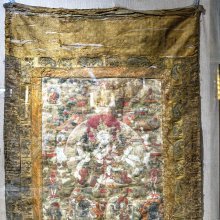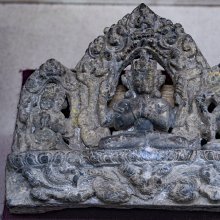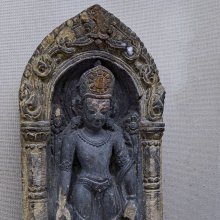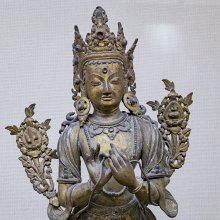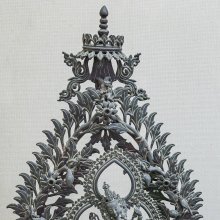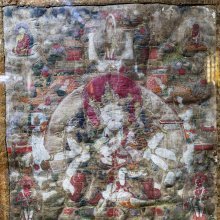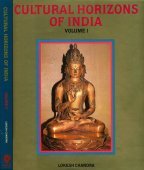Lokeshvara, Lokeśvara: 12 definitions
Introduction:
Lokeshvara means something in Buddhism, Pali, Hinduism, Sanskrit, the history of ancient India. If you want to know the exact meaning, history, etymology or English translation of this term then check out the descriptions on this page. Add your comment or reference to a book if you want to contribute to this summary article.
The Sanskrit term Lokeśvara can be transliterated into English as Lokesvara or Lokeshvara, using the IAST transliteration scheme (?).
Images (photo gallery)
(+310 more images available)
In Hinduism
Ayurveda (science of life)
Rasashastra (Alchemy and Herbo-Mineral preparations)
Source: Wisdom Library: Rasa-śāstraLokeśvara (लोकेश्वर) or Lokeśvararasa is the name of an Ayurvedic recipe defined in the fifth volume of the Rasajalanidhi (chapter 2, Rajayakshma: phthisis). These remedies are classified as Iatrochemistry and form part of the ancient Indian science known as Rasaśāstra (medical alchemy). However, since it is an ayurveda treatment it should be taken with caution and in accordance with rules laid down in the texts.
Accordingly, when using such recipes (e.g., lokeśvara-rasa): “the minerals (uparasa), poisons (viṣa), and other drugs (except herbs), referred to as ingredients of medicines, are to be duly purified and incinerated, as the case may be, in accordance with the processes laid out in the texts.” (see introduction to Iatro chemical medicines)

Āyurveda (आयुर्वेद, ayurveda) is a branch of Indian science dealing with medicine, herbalism, taxology, anatomy, surgery, alchemy and related topics. Traditional practice of Āyurveda in ancient India dates back to at least the first millenium BC. Literature is commonly written in Sanskrit using various poetic metres.
In Buddhism
Tibetan Buddhism (Vajrayana or tantric Buddhism)
Source: Wisdom Library: VajrayoginiLokeśvara (लोकेश्वर) is the name of a deity to be contemplated upon by a practicioner purifying his correspondences (viśuddhi), according to the 12th-century Abhisamayamañjarī. Lokeśvara is alternatively known by the name Rāgavajra because he destroyes all clinging (sarvāsaṅga). The contemplation is prescribed as a preliminary ritual for a yogin wishing to establish, or reestablish the union with a deity.
Lokeśvara is associated with the face and the color red. He is to be visualised as holding an attribute in his right hand and a bell in his left. The deities of the sense organs and fields are the esoteric equivalents of the deities associated with the skandhas.
Source: Wisdom Library: Tibetan BuddhismLokeśvara (लोकेश्वर) is the name of a Bodhisattva mentioned as attending the teachings in the 6th century Mañjuśrīmūlakalpa: one of the largest Kriyā Tantras devoted to Mañjuśrī (the Bodhisattva of wisdom) representing an encyclopedia of knowledge primarily concerned with ritualistic elements in Buddhism. The teachings in this text originate from Mañjuśrī and were taught to and by Buddha Śākyamuni in the presence of a large audience (including Lokeśvara).

Tibetan Buddhism includes schools such as Nyingma, Kadampa, Kagyu and Gelug. Their primary canon of literature is divided in two broad categories: The Kangyur, which consists of Buddha’s words, and the Tengyur, which includes commentaries from various sources. Esotericism and tantra techniques (vajrayāna) are collected indepently.
India history and geography
Source: Wisdom Library: India HistoryLokeśvara (लोकेश्वर) is one of the eight temples located in a space to the north of the village Paṭṭadakal, arrayed in a rectangle of about 180 x 140 m on the western bank of the river.
Source: Archaeological Survey of India: Śaiva monuments at PaṭṭadakalLokeśvara (Virūpākṣa) is the name of a temple at Paṭṭadakal in the Karnāṭa-drāviḍa style.—This is a large complex enclosed by a compound (TP04_VP_01). The main monument exhibits striking qualities such as a well-balanced distribution of built structures, harmony of forms, variety of architectural and decorative motifs, strict obedience to a principle of symmetry, which suggest a perfect unity of conception by a master architect and realization in one period.
The architectural program starts from the Liṅga, a symbol of Sadāśiva to whose service every element in the complex is dedicated. The main structure sheltering the Liṅga is called prāsāda or vimāna. It is a cubic mass of stone masonry capped by a square high tower, also entirely of stone. It encloses an inner cella open only on the east side, called garbhagṛha “womb residence”. The term vimāna is used for the tower specifically or for both base and tower. It comprises four levels, topped by a lotus-shaped small dome (śikhara) and a finial (stūpī). All obey all sides’ symmetry on the vertical axis of the Liṅga.

The history of India traces the identification of countries, villages, towns and other regions of India, as well as mythology, zoology, royal dynasties, rulers, tribes, local festivities and traditions and regional languages. Ancient India enjoyed religious freedom and encourages the path of Dharma, a concept common to Buddhism, Hinduism, and Jainism.
Languages of India and abroad
Sanskrit dictionary
Source: Cologne Digital Sanskrit Dictionaries: Edgerton Buddhist Hybrid Sanskrit DictionaryLokeśvara (लोकेश्वर).—name of a Bodhisattva: Sādhanamālā 20.11, 23.3, etc.
Source: Cologne Digital Sanskrit Dictionaries: Shabda-Sagara Sanskrit-English DictionaryLokeśvara (लोकेश्वर).—m.
(-raḥ) 1. Brahma. 2. A king. 3. A Jaina deified sage. E. loka the world, and īśvara sovereign.
Source: Cologne Digital Sanskrit Dictionaries: Cappeller Sanskrit-English DictionaryLokeśvara (लोकेश्वर).—[masculine] lord or ruler of the world.
Source: Cologne Digital Sanskrit Dictionaries: Monier-Williams Sanskrit-English Dictionary1) Lokeśvara (लोकेश्वर):—[from loka > lok] m. the lord of the world, [Śatapatha-brāhmaṇa; Mahābhārata; Rāmāyaṇa]
2) [v.s. ...] Name of a Buddha (also ra-rāja), [Horace H. Wilson; Buddhist literature]
3) [v.s. ...] of Avalokiteśvara, [Inscriptions]
Source: Cologne Digital Sanskrit Dictionaries: Yates Sanskrit-English DictionaryLokeśvara (लोकेश्वर):—[loke+śvara] (raḥ) 1. m. Idem.
[Sanskrit to German]
Sanskrit, also spelled संस्कृतम् (saṃskṛtam), is an ancient language of India commonly seen as the grandmother of the Indo-European language family (even English!). Closely allied with Prakrit and Pali, Sanskrit is more exhaustive in both grammar and terms and has the most extensive collection of literature in the world, greatly surpassing its sister-languages Greek and Latin.
See also (Relevant definitions)
Starts with: Lokeshvarapottali, Lokeshvararaja, Lokeshvararasa, Lokeshvarashataka, Lokeshvaratmaja.
Query error!
Full-text (+259): Pretasamtarpitalokeshvara, Lokeshvarashataka, Sarvalokeshvara, Sugatisamdarshanalokeshvara, Amoghapasha, Lokeshvaratmaja, Yakshamalla, Trilokavashamkara, Trailokyavashankaralokeshvara, Shadaksharilokeshvara, Harihariharivaha, Trailokyavashamkara, Hayagrivalokeshvara, Mojaghanjabalalokeshvara, Shadaknarilokeshvara, Anandadilokeshvara, Vashyadhikaralokeshvara, Potapadalokeshvara, Kamandalulokeshvara, Varadayakalokeshvara.
Relevant text
Search found 32 books and stories containing Lokeshvara, Lokeśvara, Lokesvara; (plurals include: Lokeshvaras, Lokeśvaras, Lokesvaras). You can also click to the full overview containing English textual excerpts. Below are direct links for the most relevant articles:
Vietnamese Buddhist Art (by Nguyen Ngoc Vinh)
1. Physical appearance of Avalokitesvara < [Chapter 3 - Unifying factors of the Avalokitesvara Images in South Vietnam and South East Asia]
2. Avalokitesvara images in Champa < [Chapter 3 - Unifying factors of the Avalokitesvara Images in South Vietnam and South East Asia]
3. Sculptures in Cambodia < [Chapter 4 - The Sculpture and its Reciprocal Influence]
Sripura (Archaeological Survey) (by Bikash Chandra Pradhan)
Scultures of Sadaksari-Lokesvara < [Chapter 3 - Sculptural Programme]
Scultures of Rakta-Lokesvara < [Chapter 3 - Sculptural Programme]
Bronze-icons < [Chapter 3 - Sculptural Programme]
Buddhist iconography in and outside India (Study) (by Purabi Gangopadhyay)
Kannon-bu images < [Chapter 4: Japanese Buddhist Iconography (a Comparative Study)]
Fuku-Kensaku Kannon (or Amoghapasha) < [Chapter 4: Japanese Buddhist Iconography (a Comparative Study)]
Other Bodhisattvas in Japan < [Chapter 4: Japanese Buddhist Iconography (a Comparative Study)]
The Indian Buddhist Iconography (by Benoytosh Bhattachacharyya)
108 forms of Avalokiteśvara (106): Mahāsthāmaprāpta Lokeśvara
108 forms of Avalokiteśvara (107): Vajranātha Lokeśvara
Vaishnava Myths in the Puranas (by Kum. Geeta P. Kurandwad)
Introduction to the concept of Avatara (descent) < [Chapter 4 - Significance of Vaishnava Myths]
The concept of Rama-Avatara (incarnation) < [Chapter 4 - Significance of Vaishnava Myths]
The gods of northern Buddhism (by Alice Getty)
Related products
